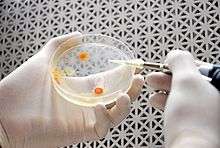Cupriavidus
Cupriavidus is a genus of bacteria that includes the former genus Wautersia.[4] They are characterized as Gram-negative, motile, rod-shaped organisms with oxidative metabolism. They possess peritrichous flagella, are obligate aerobic organisms, and are chemoorganotrophic or chemolithotrophic. Resistance to metals (including copper) has been described. These organisms have been found in both soil and in clinical isolates.[5]
| Cupriavidus | |
|---|---|
 | |
| Scientific classification | |
| Kingdom: | |
| Phylum: | |
| Class: | |
| Order: | |
| Family: | |
| Genus: | Cupriavidus Makkar and Casida 1987 |
| Species | |
|
C. alkaliphilus | |
References
- Sun, LN; Wang, DS; Yang, ED; Fang, LC; Chen, YF; Tang, XY; Hua, RM (June 2016). "Cupriavidus nantongensis sp. nov., a novel chlorpyrifos-degrading bacterium isolated from sludge". International Journal of Systematic and Evolutionary Microbiology. 66 (6): 2335–41. doi:10.1099/ijsem.0.001034. PMID 27001671.
- Estrada-de Los Santos, P; Solano-Rodríguez, R; Matsumura-Paz, LT; Vásquez-Murrieta, MS; Martínez-Aguilar, L (November 2014). "Cupriavidus plantarum sp. nov., a plant-associated species". Archives of Microbiology. 196 (11): 811–7. doi:10.1007/s00203-014-1018-7. PMID 25098225.
- Parte, A.C. "Cupriavidus". LPSN.
- Wautersia entry in LPSN [Euzéby, J.P. (1997). "List of Bacterial Names with Standing in Nomenclature: a folder available on the Internet". International Journal of Systematic and Evolutionary Microbiology. 47 (2): 590–2. doi:10.1099/00207713-47-2-590. PMID 9103655.]
- Vandamme, P; Coenye T. (Nov 2004). "Taxonomy of the genus Cupriavidus: a tale of lost and found". Int J Syst Evol Microbiol. 54 (Pt 6): 2285–9. doi:10.1099/ijs.0.63247-0. PMID 15545472.
This article is issued from Wikipedia. The text is licensed under Creative Commons - Attribution - Sharealike. Additional terms may apply for the media files.